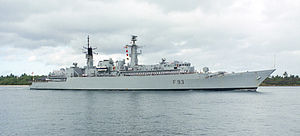This article needs additional citations for verification. (October 2021) |
 HMS Beaver, 30 June 1986
| |
| Class overview | |
|---|---|
| Builders | |
| Operators |
|
| Preceded by | Type 21 |
| Succeeded by | Type 23 |
| Subclasses |
|
| In commission | 3 May 1979 – 30 June 2011 |
| Completed | 14 |
| Active | 4 (with Brazil, Romania and Chile) |
| Retired | 10 (3 sunk as targets) |
| General characteristics | |
| Displacement |
|
| Length |
|
| Beam | 14.8 m (49 ft) |
| Draft |
|
| Propulsion |
|
| Speed |
|
| Complement |
|
| Sensors and processing systems |
|
| Electronic warfare & decoys | NATO Seagnat decoy launchers |
| Armament |
|
| Aircraft carried |
|
| Aviation facilities | Flight deck and hangar |
The Type 22 frigate also known as the Broadsword class was a class of frigates built for the British Royal Navy. Fourteen were built in total, with production divided into three batches.
Initially intended to be anti-submarine warfare frigates as part of NATO contribution, the ships became general purpose warships.
HMS Cornwall was the last Royal Navy Type 22 frigate, retired from service on 30 June 2011.[1][2]
Five Type 22s were scrapped and two more were sunk as targets. The seven other vessels were sold to the Brazilian, Romanian and Chilean navies; four of these remain in service, one was sunk as a target, one laid up, and one sold for scrap.
- ^ "HMS Cumberland faces scrap heap". News & Star. 17 December 2010. Archived from the original on 22 March 2012. Retrieved 26 January 2011.
- ^ "Defence Policy and Business | Changes to Royal Navy's surface fleet announced". Defence News. Ministry of Defence. 20 February 2007. Retrieved 26 January 2011.